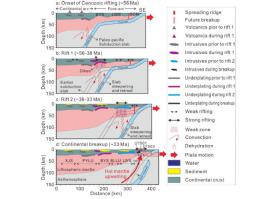Gondwana Research ( IF 6.1 ) Pub Date : 2022-07-03 , DOI: 10.1016/j.gr.2022.06.015 Zhongxian Zhao , Zhen Sun , Ning Qiu , Minghui Zhao , Jiazheng Zhang , Fucheng Li , Jian Lin , Eun Young Lee

|
The northern South China Sea has complex rifting-magmatic styles, which are significantly distinct from the Atlantic end-member passive margins that initiated rifting in a craton, and was argued to originate from a subducted setting. Here we propose a new kinematic method to calculate the paleo-lithospheric structure and reconstruct the rifting processes along a ∼400 km seismic line in the northern South China Sea margin. The detailed paleo-tectonic setting and its linkage with the rifting-magmatic processes are explored. Seismic-gravity analysis reveals a “boudin-type” passive margin with a wide distal domain (>200 km) comprising discrete hyperextended zones of the Baiyun Sub-basin, Liwan Sub-basin and a narrow continent-ocean transition (<30 km). The calculated pre-rift lithospheric thickness declines abruptly from ∼100-80 km in the proximal margin to ∼40 km in the distal margin, implying that the pre-rift margin was affected by a flat to steep slab of the subducted paleo-Pacific. The steep slab lying beneath the proximal margin formed an arc where the high-density lower crust probably has a pre-rift age. The flat slab beneath the Baiyun Sub-basin to the southern conjugate margin formed a forearc. As the slab steepened and retreated to beneath the Baiyun Sub-basin in rift phase 1 (∼56-38 Ma) and Liwan Sub-basin in rift phase 2 (∼38-33 Ma), the mantle convection and slab dehydration weakened the above lithosphere successively, promoting seaward migration and younging of strong faulting, magmatic underplating, intrusion, and eruption. When slab broke suddenly at ∼33 Ma in the continent-ocean transition, the deep hot asthenosphere upwelled to rupture the lithosphere abruptly and induced intense magmatism. Modelling results further show that the paleo-crustal thickness and basement erosion are both fundamentally important in assessing and understanding the crustal thinning.
中文翻译:

南海北部被动边缘古岩石圈构造与裂谷-岩浆作用
南海北部具有复杂的裂谷-岩浆样式,与大西洋端元被动边缘明显不同,后者在克拉通中开始裂谷,并被认为起源于俯冲环境。在这里,我们提出了一种新的运动学方法来计算古岩石圈结构并重建南海北部边缘~400 km地震线沿线的裂谷过程。探索了详细的古构造背景及其与裂谷-岩浆过程的联系。地震-重力分析揭示了一个“布丁型”被动边缘,具有较宽的远端域(>200 km),包括白云次盆地、荔湾次盆地的离散超伸展带和狭窄的大陆-海洋过渡区(<30 km) . 计算的裂前岩石圈厚度从近端边缘的~100-80 km突然下降到远端边缘的~40 km,这意味着裂谷前边缘受到俯冲古太平洋平坦到陡峭板片的影响。近缘下的陡峭板片形成弧形,高密度下地壳可能具有裂谷前时代。白云次盆地下方至共轭南缘的平板形成了前弧。随着裂谷一期(~56-38 Ma)板片变陡后退至白云次盆地下方和裂谷二期(~38-33 Ma)荔湾次盆地下方,地幔对流和板片脱水减弱了上述作用。岩石圈先后推动强断裂、岩浆底侵、侵入、喷发等向海迁移和年轻化。当大陆-海洋过渡的 33 Ma 板片突然破裂时,深热软流圈上涌使岩石圈突然破裂,并引发强烈的岩浆活动。建模结果进一步表明,古地壳厚度和基底侵蚀对于评估和理解地壳变薄具有根本性的意义。



























 京公网安备 11010802027423号
京公网安备 11010802027423号